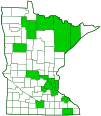Catskill potter wasp
(Ancistrocerus catskill)
Conservation • Description • Habitat • Ecology • Distribution • Taxonomy
Conservation Status |
|
|||||||
| IUCN Red List | not listed |
|||||||
| NatureServe | NNR - Unranked |
|||||||
| Minnesota | not listed |
|||||||
Description |
||
Catskill potter wasp is a relatively common potter wasp. It occurs in the United States in the east from Maine to virginia, west to Minnesota and Illinois, and in the west in Colorado. In Canada it occurs from Nova Scotia west to southern Ontario. Outside of these ranges there are many widely scattered records. Adults are small and black with yellow markings. The front part of the body (mesosoma) is connected to the rear part (metasoma) by a narrow waist (petiole). The female has a 5⁄16″ to ⅜″ (7.5 to 10.0 mm) forewing length. The head is black. There are two large compound eyes, one on each side of the head, and three small simple eyes (ocelli) in a triangular pattern at the top of the head between the compound eyes. The inner margin of each compound eye is notched. The antennae are thread-like and have 13 segments, including a long first segment (scape) at the base, a short second segment (pedicel), and a whip-like section (flagellum) with 11 segments (flagellomeres). The upper side of all antennal segments is black. The underside of the scape is yellow, forming a continuous stripe that is not narrowed in the middle. The underside of the pedicel and each flagellum is yellowish-brown. The last flagellum is not hooked at the tip. The jaws (mandibles) are long and knife-like. The plate on the face (clypeus) is black with a yellow spot on each lateral margin and a pair of yellow spots on the lower margin. There is a yellow spot on the head between the antennae bases, and a small yellow spot (postocular spot) behind each compound eye. The thorax is black and has three segments, the prothorax, mesothorax, and metathorax. However, the first segment of the abdomen (propodeum) is fused to the thorax, giving the thorax the appearance of having four segments. The upper plate on the prothorax (pronotum) is short and collar-like. It does not have a narrow transverse ridge (carina). It extends rearward on the sides to the plate at the base of each wing (tegula). It appears horseshoe-shaped when viewed from above, triangular when viewed from the side. It is mostly black except for a yellow band on the front margin of the upper (dorsal) surface. The band narrows in the middle and tapers narrowly to each side. On the mesothorax, the large front plate (mesoscutum or scutum) is entirely black, with no yellow markings. The smaller rear plate (scutellum) has a pair of rectangular yellow spots. The spots are bold and are narrowly separated in the middle. On the upper surface of the metathorax (metanotum) there is a horizontal yellow line. The line is straight or slightly curved, and equal in length or shorter than the two spots together. It is rarely interrupted in the middle. There is a small yellow spot at the base of each forewing and a larger yellow spot on the side of the thorax below the wing bases. The first and second abdominal segments form a petiole that connect the abdomen to the thorax. The first segment of the metasoma is wider than long and only half as long as the second segment. It is black with a yellow band at the rear. The band broadens slightly toward each side. The second segment has a broad yellow band at the rear and is almost as long as the remaining segments combined. The remaining segments have a narrow yellow band at the rear. The wings are smoky brown with dark veins. They are folded longitudinally over the body when at rest. On the forewing, the first discoidal cell is very long, about half the total length of the wing. There are three submarginal cells. The legs are black and yellow. The first segment (trochanter) is not divided – it has just one segment. On each leg the third segment (femur) is mostly black, yellow just at the tip, and the fourth segment (tibia) is yellow above, black below. The tibiae on the middle leg has a single spur at the tip. The last part of each leg (tarsus), corresponding to the foot, has five segments. There is a pair of claws at the tip of each tarsus. The claws are split (cleft) at the end. The male is smaller, with a 3⁄16″ to 5⁄16″ (5.5 to 7.5 mm) forewing length. The antennae have just 12 segments. The last flagellum is hooked at the tip. The spot between the antennae bases is smaller. The clypeus is entirely yellow. The postocular spot is sometimes very small. The spots on the rear of the thorax are smaller and the band is usually missing, sometimes reduced to a pair of indistinct lines. The metasoma has seven visible segments. |
||
Size |
||
Female forewing length: 5⁄16″ to ⅜″ (7.5 to 10.0 mm) Male forewing length: 3⁄16″ to 5⁄16″ (5.5 to 7.5 mm) |
||
Similar Species |
||
Habitat |
||
|
||
Ecology |
||
Season |
||
|
||
Behavior |
||
The wings are folded longitudinally over the body when at rest. |
||
Life Cycle |
||
The female nests in a preexisting cavity: in a boring in wood or a twig, in abandoned mud dauber nests and deserted burrows of ground-nesting bees. It rarely constructs a nest from mud. |
||
Larva Hosts |
||
|
||
Adult Food |
||
|
||
Distribution |
||||
|
Sources |
|||
| 2/4/2023 | ||||
Occurrence |
||||
|
||||
Taxonomy |
|||
Order |
Hymenoptera (Ants, Bees, Wasps, and Sawflies) | ||
Suborder |
Apocrita (Narrow-waisted Wasps, Ants, and Bees) | ||
| No Rank | Aculeata (Ants, Bees, and Stinging Wasps) | ||
Superfamily |
vespoidea (vespoid wasps) | ||
Family |
vespidae (hornets, paper wasps, potter wasps, and allies) |
||
Subfamily |
Eumeninae (potter and mason wasps) | ||
Genus |
Ancistrocerus | ||
Synonyms |
|||
|
|||
Common Names |
|||
Catskill potter wasp |
|||
Glossary
Clypeus
On insects, a hardened plate on the face above the upper lip (labrum).
Femur
On insects and arachnids, the third, largest, most robust segment of the leg, coming immediately before the tibia. On humans, the thigh bone.
Flagellomere
A segment of the whip-like third section of an insect antenna (flagellum).
Mesosoma
In Hymenoptera: the front part of the body, consisting of all three segments of the thorax and the first segment of the abdomen, to which the wings are attached.
Metasoma
In Hymenoptera: the armored rear part of the body, consisting of the second segment of the abdomen and all segments posterior to it.
Pedicel
On plants: the stalk of a single flower in a cluster of flowers. On insects: the second segment of the antennae. On Hymenoptera and Araneae: the narrow stalk connecting the thorax to the abdomen: the preferred term is petiole.
Petiole
On plants: The stalk of a leaf blade or a compound leaf that attaches it to the stem. On ants and wasps: The constricted first one or two segments of the rear part of the body.
Pronotum
The exoskeletal plate on the upper side of the first segment of the thorax of an insect.
Propodeum
In Hymenoptera: the last segment of the thorax, anatomically the first segment of the abdomen.
Scape
In plants: An erect, leafless stalk growing from the rootstock and supporting a flower or a flower cluster. In insects: The basal segment of the antenna.
Tarsus
On insects, the last two to five subdivisions of the leg, attached to the tibia; the foot. On spiders, the last segment of the leg. Plural: tarsi.
Tegula
A small, hardened, plate, scale, or flap-like structure that overlaps the base of the forewing of insects in the orders Lepidoptera, Hymenoptera, Diptera, and Homoptera. Plural: tegulae.
Tibia
The fourth segment of an insect leg, after the femur and before the tarsus (foot). The fifth segment of a spider leg or palp. Plural: tibiae.
Visitor Photos |
|||||
Share your photo of this insect. |
|||||
| This button not working for you? Simply email us at info@MinnesotaSeasons.com. Attach one or more photos and, if you like, a caption. |
|||||
Alfredo Colon |
|||||
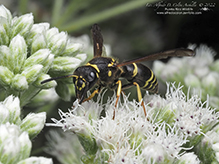 |
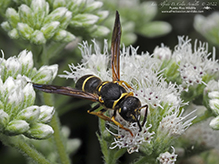 |
||||
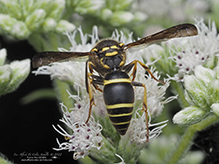 |
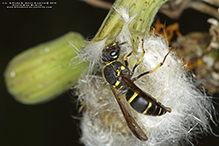 |
||||
 |
|||||
MinnesotaSeasons.com Photos |
|||||
|
|||||

Slideshows |
||

Visitor Videos |
|||
Share your video of this insect. |
|||
| This button not working for you? Simply email us at info@MinnesotaSeasons.com. Attach a video, a YouTube link, or a cloud storage link. |
|||
Other Videos |
|||
| Ancistrocerus (vespidae) Hymenoptera of North America |
|||
About
Aug 13, 2021 This video is intended to assist those who are looking to identify hymenopteran specimens or for anyone who wants to familiarize themselves with the order. |
|||


Created: 2/4/2023
Last Updated:
